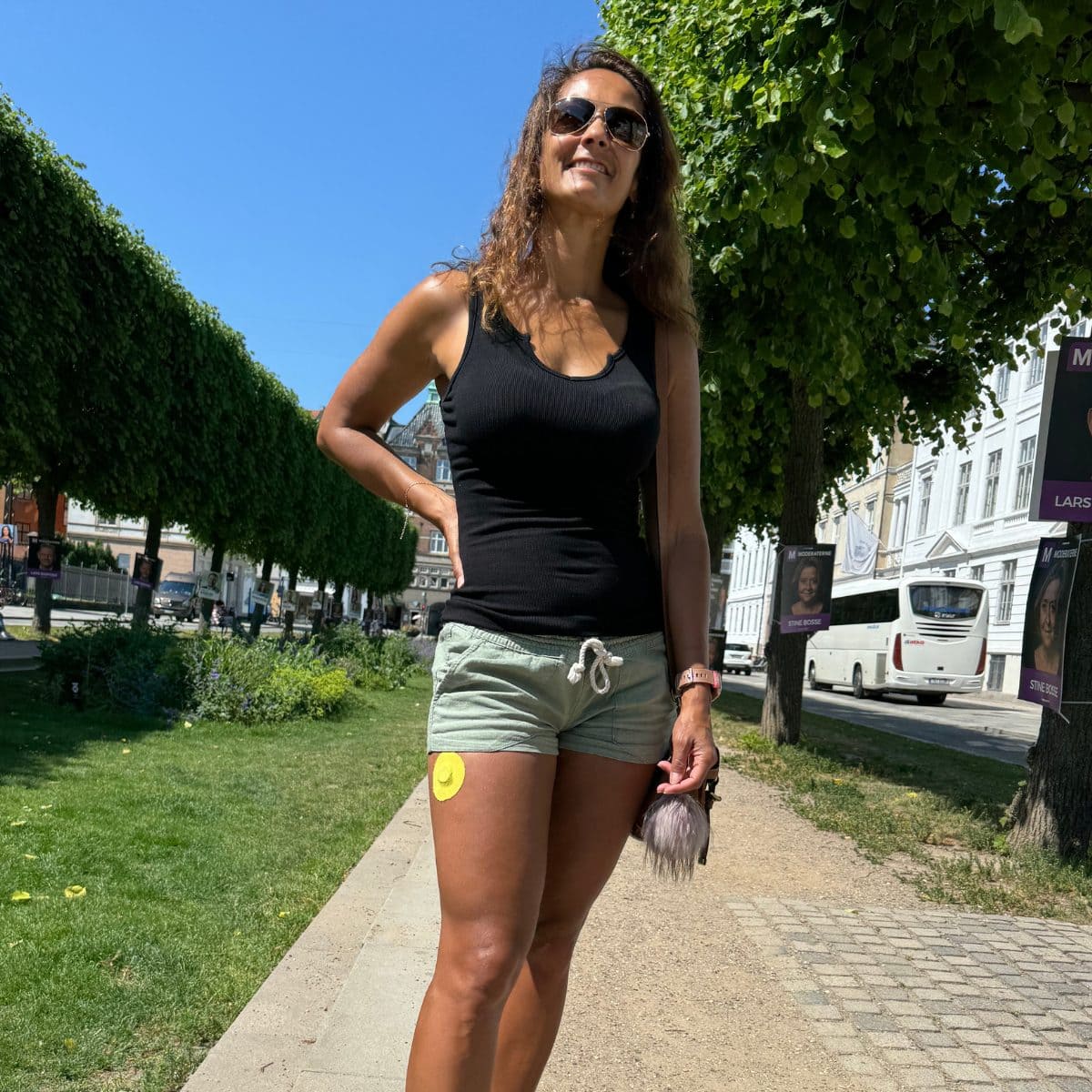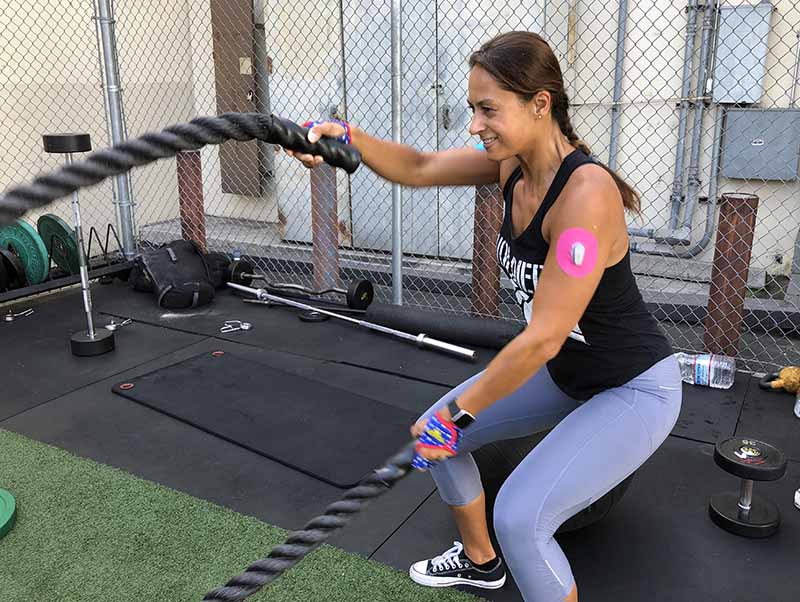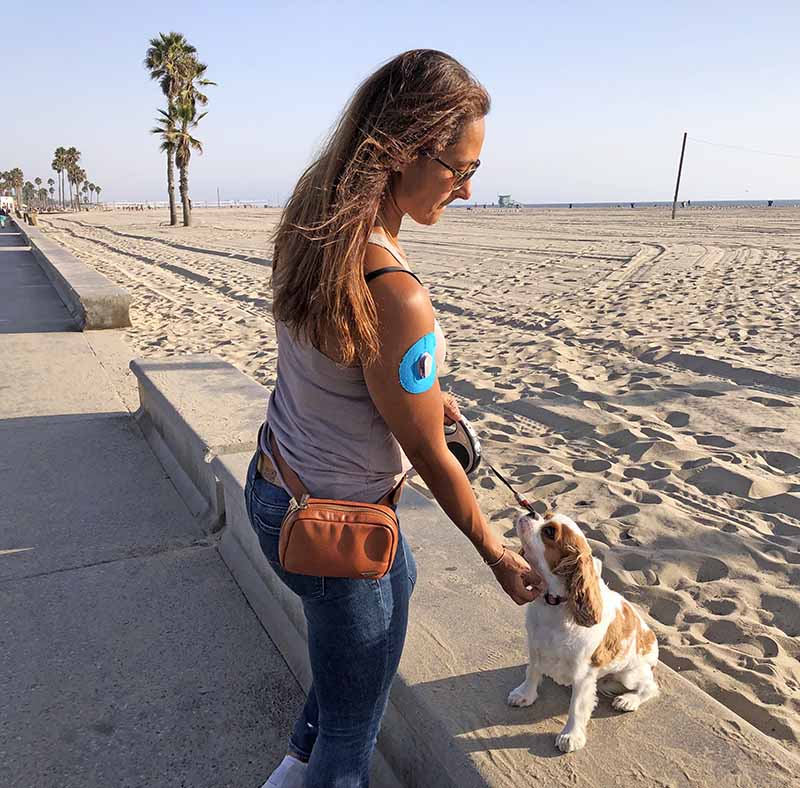This post may contain affiliate links. Please read our disclosure.
If you’re physically active, sweat a lot, or your skin just doesn’t get along with the adhesives of your Continuous Glucose Monitor (CGM), you undoubtedly know the frustration of the CGM tape peeling and your sensor being at risk of falling off.
This has been a huge problem for me in the past. Not only do I live in Miami (with summer year-round), but I’m very active and the CGM tape of my Dexcom G7 simply can’t keep up with my lifestyle.
Also, the Dexcom G7 overlay tape makes my skin break into hives.
My solution is to add a soft fabric patch over my sensor to extend its lifetime, make sure it doesn’t fall off, and prevent skin reactions.
But not all patches are created equal and, in this post, I’ll show you why Skin Grip is my favorite go-to patch.

This post is sponsored by Skin Grip, but the opinions are my own and I used Skin Grip patches before they became a sponsor.
What I look for in a CGM patch
When it comes to CGM patches, the most important factors for me are
- Comfort
- Ease of use
- Affordability
- The design
Patch Comfort
I have very sensitive skin and most patches, including the Dexcom G7 overlay tape, will make my skin angrily red and itchy.
Because of that, I always look for patches that will allow my skin to breathe but where the glue is still strong enough that the patch will stay on for at least 10 days, but not so strong that it will take my skin off when I peel off the patch.
There are many different options available, and the patches are generally either:
- a paper or plastic-like material
- a fabric material (like Skin Grip)
I’ve found that the paperlike material is very stiff so it doesn’t stick to the skin as well and will start to peel within a few days.
The plastic, on the other hand, will stay on for a long time, but my skin clearly doesn’t like it and will look red and irritated within the first day.
So I tend to gravitate towards fabric patches that Skin Grip provides.
Some have suggested that I just add some Skin Tac Glue (an additional body adhesive) under some of the other patches to make them stick better. I guess I could do that, but why not choose one that will stick comfortably by itself?
I do sometimes use an Adhesive remover. Uni-Solve Adhesive Remover Wipes easily remove the patches and any residue adhesive after the 10 days that the Dexcom G7 lasts.
Since the patch sticks so well, it’s a great way of easily removing the patch (especially if you apply the patch in a place with body hair).

Patch Ease of Use
It clearly shouldn’t require an advanced degree to apply a CGM patch, but if you have 10 thumbs like I do or like to place the patch in places that are hard to reach (like the back of the arm), it can be a little tricky.
With some patches, it’s quite tricky to get the patch off the paper that protects the adhesive. Some patches, like the Dexcom G7 overlay tape that comes in the box, even require that you remove the whole piece of paper before applying it to the skin.
The issue with removing all of the paper is that now you have a floppy and VERY sticky patch, and the likelihood of just gluing the patch to itself is high (yes, I’ve done that more than once).
What I like about Skin Grip is that the paper comes off in 4-5 sections, so you can choose to remove one or none of the paper pieces before you apply the patch to the skin.
I like to place it over the sensor and then remove one section, push it down on the skin to make sure it sticks, and then work my way around to the other sections. Works like a charm and I haven’t had to discard a single patch yet from having it adhere to itself.
This method also means that I can apply it with one hand, without help. So I can wear my sensor on my arm without having to ask my husband for help every time I want to change a patch.
You can see how I put the Skin Grip on a Dexcom G6 in this video:
Patch Affordability
Let’s face it, living with diabetes is very expensive in most countries, so CGM patches are not really something I can spend a ton of money on.
I’ve tried other patches with intricate designs, and they are fun, but I don’t want to spend $3-4 per patch on a regular basis.
A pack of Skin Grip patches is $24.99-29.99 and includes 20 single-use patches. That’s only $1.25-$1.50 per patch, which is very affordable relative to the other patches currently available on the market.
Skin Grip also launched some special edition patches (see their Classic collection). Those are a bit more expensive at $24.99 for 10 patches.
You can use code DIABETESSTRONG for 10% off on the Skin Grip website.

Design
The final thing I consider when it comes to patches is the design. That includes how they are cut and what they look like.
For Dexcom G7, I prefer an overlay tape without the cutout for the transmitter, and Skin Grip has that available. It doesn’t reduce the sensor signal and it completely secures the sensor.
I also enjoy the vibrant colors; I don’t remember the last time I bought a “tan” overlay tape. If you want to try different colors, they have a “rainbow” pack with 10 different fun colors.

Where to get your SkinGrip
SkinGrip can be purchased on the SkinGrip website or on Amazon. They provide patches for Dexcom G6 and G7, Medtronic Guardian and Enlite, Abbott Freestyle Libre 2 and 3, Insulet OnmiPod and infusion sets.
You can use code DIABETESSTRONG for 10% off on the Skin Grib website.




Mary Lisa
Great tips on making your CGM stay put with Skin Grip! It’s so important for comfort and accuracy.
Jim Slocomb
I just recently started using the Libre 2 CGM and have noticed a significant improvement in my average glucose. I first bought the Honyou Freestyle Libre Sensor Covers 25Pack Waterproof Liber Sensor Adhesive Patches Flesh Flexible CGM Patches Without Glue in The Center-Enlite-Guardian-Freestyle Libre 14 Day Sensor Patches and without the glue in the center of the patch, they seemed to stay on quite well, lasting the full 14 days. I misplaced those and had to buy more but decided to buy the Skin Grip brand. The Skin Grip patches have adhesive in the center and I was wondering if I should leave the center backing paper on the patch or remove it. I guess by removing it the sensor stays pretty anchored; however, it makes application tricky as you only get one chance to get the patch directly over the sensor. Maybe I should anchor the center of the patch first?
Christel Oerum
I don’t believe you are supposed to cover the actual sensor, but I’ve seen people do it. I’ll usually loosen the paper (not take it off), “anchor” the sensor, and then peel each paper panel off at a time. Works for the Dexcom sensor but might be a little different for the Libre
Kathie Vaught
I have work a cgm for many, many years and have always covered it. I wore a Dexcom, now Medtronic cgm. The only time I did not cover it was when I tried the Eversense.
Gerard
Hi. I am an insulation contractor. I live in Tennessee where attic temperatures can get 140 degrees. I sweat profusely and can’t get my CGM to stay on my skin for more than 2 days. Any suggestions?
Christel Oerum
Have you tried adding a skin grip (mentioned in the article)?
Ben
Does wearing the sensor at your arm (between upper tricep below deltoid) get in the way of arm exercise. Meaning do you feel the needle when doing arm exercises?
Christel Oerum
No, it has never bothered me when exercising. The sensor is so thin that I think (wouldn’t recommend it) you can place it in muscle and still be ok
Ty
Hey I’m new to all of this, and I’m a bodybuilder and it says to put it on the abdominal but with lifting I can’t wear a lifting belt, where at on the arm do you put it if you don’t have any fat on your arm?
Christel Oerum
I like to place it right below the deltoid on the back/side of my arm (not an FDA-approved placement). I’m working on a YouTube video on where you can place the sensor that will be published Saturday, March 20th, so keep an eye out for that (https://www.youtube.com/c/Thefitblog)
Shaylee Packer
As you mentioned, it is a good idea to find a patch that allows your skin to breath, but still does its job. My neighbor has told me that they have a hard time getting their patches to stay on while running and working out. I will have to share this article with them, and see if it helps them out at all.
Mike Farley
I read your skin patch review late last year. Based on it, I decided to try Skin Grip. I love them. I extend my sensors. When I change sensors, I use skin tac first, going up over the Dexcom patch, and apply a Skin Grip. I typically get 12-15 days from that combo.
Thanks for your articles, they’re great!
Christel Oerum
Excellent, so glad it was helpful (and that you get that much sensor time!!)
Deb
Excellent article
I have trouble with mine and also have sensitive skin so very much appreciated
Christel Oerum
You’re welcome. I hope this will be a good solution for you
Kristin
Hi Christel!
Do you find that the SkinGrip patches will stay on for the life of the CGM? I have been cutting my own patches out of athletic tape but find that showering/water makes them lose their stickiness after 5-7 days. It is tricky removing the tape and replacing it without disturbing the sensor. Any tricks for this? I have a Freestyle Libre 14 day- so am really looking for something that will stay on as long as my sensor.
Thanks! Kristin
Christel Oerum
I usually don’t wear the patch for the full 10-days since I only apply it when my CGM starts to peel. But yes, I do find that it sticks and for some reason, it seems that the tan ones sticks the most.
If no matter what you do, your patch peels, you can add a little Skin Tac (basically body glue) to the edges and glue them down
Need Anap
I’m not sure about the Libre. I use a Dexcom G4. I use Opsite Flexifilm 4″ size. I cut a rectangle 8 squares long then cut 2 squares away and cut 8 squares away from the middle going in 3 squares. I lay one of these on one side and another one on the other side of my sensor. Then in a few days (a week) I can lay down a full 8 squares on each side. Then any other spots, I can add more tape (I also buy the 2″ size that I mostly use around my tslim pump sites (cut a crooked hole in the middle). Sorry, long comment. I like patches but can’t always afford them.